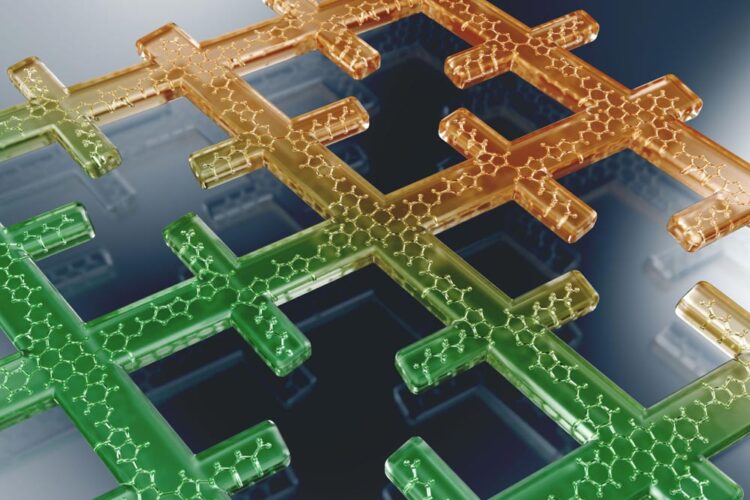New material: Rapid color change

Colour change in electrochromic materials
© Vera Hiendl, e-conversion / LMU
Smart glass can change its color quickly through electricity. A new material developed by chemists of Ludwig-Maximilians-Universität (LMU) in Munich has now set a speed record for such a change.
On the highway at night. It rains, the bright headlights of the car behind you are blinding. How convenient to have an automatically dimming rearview mirror in such a case. Technically, this helpful extra is based on electrochromic materials. When a voltage is applied, their light absorption and color change. Controlled by a light sensor, the rearview mirror can thus filter out strongly dazzling light.
Recently, experts discovered that, in addition to established inorganic electrochromic materials, a new generation of highly ordered lattice structures can also be equipped with this capability: so-called Covalent Organic Frameworks, COFs for short. They consist of synthetically produced organic building blocks that, in suitable combinations, form crystalline and nanoporous networks. Here, the color change can be triggered by an applied electrical voltage which causes an oxidation or reduction of the material.
The LMU-team led by Thomas Bein (Physical Chemistry, LMU Munich) has now developed COF structures whose switching speeds and coloration efficiencies are many times higher than those of inorganic compounds. COFs are attractive because their material properties can be adjusted over a wide range by modifying their molecular building blocks. Scientists at LMU Munich and the University of Cambridge took advantage thereof to design COFs that were ideal for their purposes.
“We have made use of the modular construction principle of the COFs and designed the ideal building block for our purposes with a specific thienoisoindigo molecule”, says Derya Bessinger, first author and PhD student in the group of Thomas Bein. Incorporated into a COF, the new component demonstrates how strongly it can improve the COF’s properties. “For example, with the new material, we cannot only absorb the shorter-wavelength UV light or small parts of the visible spectrum, but also achieve photoactivity well into the near-infrared spectral regions”, says Bessinger.
At the same time, the new COF structures are much more sensitive to electrochemical oxidation. This means that even a low applied voltage is sufficient to trigger a color change of the COFs, which is also completely reversible. In addition, this happens at very high speed: the response time for a complete and distinct color change by oxidation is around 0.38 seconds, while the reduction back to the initial state takes only about 0.2 seconds. This makes the e-conversion team’s electrochromic organic frameworks among the fastest and most efficient in the world.
Two things in particular are responsible for the high speed: The conductive framework structure of the COFs enables fast electron transport in the lattice. And thanks to an optimized pore size, the surrounding electrolyte solution can quickly reach every corner.
This is essential because the positive charge generated in the oxidized COF structure must quickly be charge-compensated by negative electrolyte ions. Last but not least, the product of the Munich scientists has a very high stability. Long-term tests showed that the material was able to maintain its performance even after 200 oxidation-reduction cycles.
With these fundamental findings, the publication advances the development of a new class of high-performance electrochromic coatings. The obvious demand for this is shown by current applications of such “smart glass” as switchable solar-protection and privacy-shield windows for whole building facades.
All latest news from the category: Materials Sciences
Materials management deals with the research, development, manufacturing and processing of raw and industrial materials. Key aspects here are biological and medical issues, which play an increasingly important role in this field.
innovations-report offers in-depth articles related to the development and application of materials and the structure and properties of new materials.
Newest articles

You are What You Eat—Stanford Study Links Fiber to Anti-Cancer Gene Modulation
The Fiber Gap: A Growing Concern in American Diets Fiber is well known to be an important part of a healthy diet, yet less than 10% of Americans eat the minimum recommended…

Trust Your Gut—RNA-Protein Discovery for Better Immunity
HIRI researchers uncover control mechanisms of polysaccharide utilization in Bacteroides thetaiotaomicron. Researchers at the Helmholtz Institute for RNA-based Infection Research (HIRI) and the Julius-Maximilians-Universität (JMU) in Würzburg have identified a…

ASXL1 Mutation: The Hidden Trigger Behind Blood Cancers and Inflammation
Scientists show how a mutated gene harms red and white blood cells. LA JOLLA, CA—Scientists at La Jolla Institute for Immunology (LJI) have discovered how a mutated gene kicks off…



